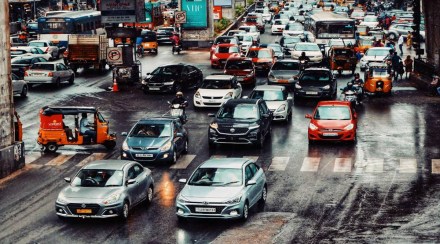By Jerin Venad,
India is in a state of rapid urbanization, making our cities even bigger. When millions of people flock to the same place, some inconveniences are bound to happen. One of the biggest gripes people have in cities without a convenient mass transit system, are the frustrating commutes between home and office.
Let’s look at Mumbai, for instance. Even though efficient modes of travel like trains and buses account for over 40% of its 20 million population, they are still overcrowded thanks to Mumbai’s high population density. This severely hampers commuter comfort, which for some people is non-negotiable.
Those who can afford it, opt for the more comfortable and somewhat predictable commute options in private vehicles like cars and cabs. However, the growing population has made sure that the roads aren’t spared from becoming congested either. Today, 65% of Mumbai’s entire road space is taken up by just 8-10% of its population with their private vehicle usage. Unsurprisingly, this has expanded commute times to over three hours every day. In the most acute cases, traffic snarls and resulting roadblocks have caused schools to declare holidays, and commuters stranded on the roads for over six hours on their way back home.
Also read| Urban mobility: The need and future in India
With population growth outpacing the construction of road space by a mile, using private cars is clearly not a sustainable way to commute. The only viable solution to ease congestion is higher adoption of space-efficient transit i.e., shared transit.
There is, however, no one-size-fits-all solution. Given the diversity and outspread of the city’s population, an ideal commute means different things for different people. While some look for affordability, others value a hassle-free experience that is comfortable and convenient. Whether it’s the metro, local trains, auto-rickshaws or buses, all urban transit options play a role in catering to these needs.
Also read| Urban Mobility: What causes India’s congestion?
An encouraging development has been the growth of public transport in Indian cities in the past 5 years itself. With the introduction of a brand-new fleet of BEST buses in Mumbai, the development of the metro network and the promise of new policies towards incentivizing the daily private car owners to make the switch, governments and private players are making determined steps towards solving this. There is an opportunity for this growing infrastructure to be supplemented with improved last mile connectivity, which would make journeys more seamless.
However, it will likely take more to persuade some others who are used to the comforts of their own cars.
Building for the urban car owner
Mass transit for a discerning customer e.g. most private vehicle owners, will only work if the experience is objectively better than what a car or a cab offers. Now this is not a particularly high bar, considering how exhausting it is to drive through Mumbai traffic, and how unreliable (and prohibitively expensive) cabs are. For example, premium buses that offer a comfortable, seated ride, and are as fast as a car, are a good starting point. If such transportation systems operate periodically, thereby helping accommodate flexible schedules, they can become a realistic daily alternative. The space-efficient nature of shared transit ensures that it stays affordable.
Needless to say, reliability goes a long way in building trust with such a customer, who has little tolerance for any unpredictability around timeliness, safety and comfort. Technology helps build this trust further. Features like a simple booking platform, seat selection, and live tracking give the travelers a sense of control of their commute, with minimal effort on their part.
Furthermore, thoughtfully designed, aesthetic travel spaces enhance the ride experience and feel good to travel in. A space that is both functional—allowing you to make the most of your commute time—and pleasing to look at, ensures that the switch from the comfort of one’s car doesn’t feel like a compromise.
For the longest time, public transport has never been seen as a viable solution for city traffic because it has been designed primarily for the cost-conscious audience—built for efficiency rather than comfort. However, as mass transit systems grow, solutions that cater to the needs of the discerning customer will be the real difference-maker.
(The author is Co-founder & CEO at Cityflo. Views expressed are personal and do not reflect the official position or policy of the FinancialExpress.com.)
